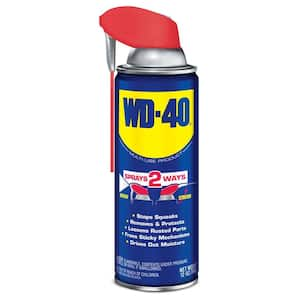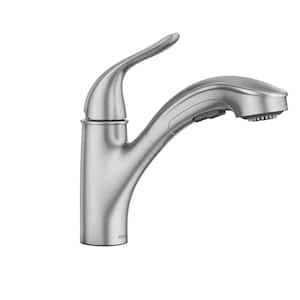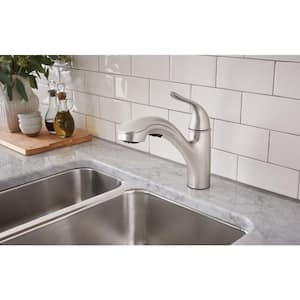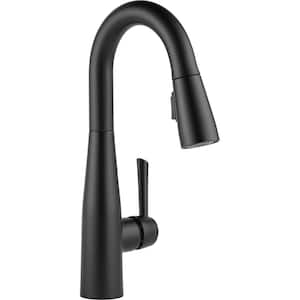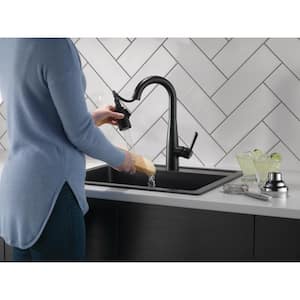
Difficulty
Intermediate
Duration
Under 2 hours
Upgrading your kitchen faucet is an affordable way to improve the convenience and functionality of your kitchen. Depending on the number of holes and the style of your kitchen sink, the process will vary, but is still fairly easy. This guide will show you how to remove or how to change a kitchen sink faucet. Read on for step-by-step instructions on how to install a single-handle kitchen faucet, not a double handle kitchen faucet. Your kitchen will be back up and running in no time.
Prep for Installation

- Before installing a new kitchen faucet, be sure to go underneath your kitchen sink and check how many holes your existing sink uses. While a one-hole faucet can work in a 2-hole sink, the same won’t be true for a 2 or 3-hole faucet in a one-hole sink.
- Since much of the job will be done on your back, a pillow will make the work easier to bear. Having a flashlight handy may also be helpful, along with a shallow pan and a couple of old towels standing by to catch any water. You should wear safety glasses to protect your eyes from falling debris.
- Clear out all of the products and supplies under the sink.
- If you have an electrical outlet beneath your sink, turn off power to it before you remove the old faucet.
- We will show you how to install a single-handle kitchen faucet first as well as how to install a two-handle kitchen faucet. Let's start with the single-handed kitchen faucet.
Shut Water Off at Supply Valves

- Reach in underneath the cabinet and shut off the hot and cold water supply valves by turning them clockwise. If you don’t have stop valves already installed, you’ll need to turn off the water to the entire house.
- If you have difficulty, try using a rag or a pair of pliers to improve your grip.
- With the water turned off, open up the faucet handles to relieve any pressure in the lines.
Disconnect Water Supply Lines

- To remove the old faucet, you’ll first need to go under the sink and disconnect the supply lines that run from the faucet down to the hot and cold valves. Each supply line is connected to the corresponding valve by a threaded nut.
- Use an adjustable wrench to remove each nut by turning it counterclockwise. As you do, make sure you stabilize the water pipe while you loosen the supply lines to prevent compromising the connections behind the cabinets.
- Once you’ve disconnected the water supply line on one side, repeat the process for the other side.
- If the valve drips even though the handle is turned completely off, it means you have a faulty valve. You’ll need to turn off the water to the entire house to replace it.
Remove Faucet Connections

- You’ll need to take out the old supply line connections to your faucet before you can remove it.
- On a two-handle centerset faucet, the two water supply lines are connected directly to the hot and cold valves. Because the mounting nuts securing the faucet are installed first, you’ll need to unscrew the supply line connections before you can remove them.
- For a single handle faucet, all of your water connections will be part of the spout assembly, since there are no hot and cold handles. On faucets like this where the supply lines are built in, any mounting hardware is made to slide directly over the lines.
One of the difficulties in taking out the old faucet is reaching up into this tight space and gaining enough leverage to remove the connections.
There are a couple of tools that will make this job easier:
- A basin wrench contains a ratcheting head with teeth designed to grip hard-to-reach retaining nuts behind the sink. The handle pivots 90 degrees allowing you to turn it from below.
- The Model 2006 Faucet and Sink Installer is a multipurpose tool designed for several under-the-sink applications.
- After unscrewing the nuts connecting the supply lines to the hot and cold valves, use the basin wrench to take off the nut connecting the diverter to the sprayer hose. If you’re positive you won’t be using the old faucet again, you can cut the line with a pipe or tubing cutter.
- Once you’ve disconnected all of the water lines under the sink, you’re ready to remove the mounting hardware.
Remove the Old Faucet

Tip: If any nuts or mounting hardware are rusted or difficult to remove, apply a penetrating oil like PB Blaster to loosen. Give it time to soak in. You may need more than one application.
- The old faucet will be connected to the underside of the cabinet by some type of mounting hardware. A single handle kitchen faucet will typically have the mounting hardware connected to a single shank that contains the hot and cold supply lines.
- For a two handle centerset faucet, the mounts will usually be found on the hot and cold valve bodies. You’ll need to remove all of the mounting hardware in order to remove the faucet.
- With the mounting hardware removed, the faucet should lift out. You may need to apply pressure to break any caulk seal.
- When you’re finished, clean the area around the sink with an approved cleaner before installing your new faucet.
Install New Faucet

- For this project, we’re installing a single handle centerset faucet with an escutcheon plate. The hot and cold supply lines are built directly into the faucet, and it also has a diverter, which will connect to a side sprayer. Refer to the manufacturer’s instructions for the proper assembly of your new faucet.
- If you’re doing a one-hole installation, you will not use the escutcheon plate. There should be separate components supplied with your faucet if you’re planning to use this configuration. But if you have a three-hole installation, the escutcheon is needed to cover up the two outside holes. It should also have a gasket to seal the gap between the escutcheon and the countertop.
- A single handle faucet has hot and cold valves that are part of the spout assembly. In many cases, it will also have flexible supply lines built in as well. Some faucet types have state of the art supply lines called PEX tubing already installed as part of the hot and cold valves of the faucet.
- On other faucets, the hot and cold valves have a threaded nut, and you’ll need to attach your own flexible supply lines. This is typically a one half inch male connection coming out of the faucet. Make sure you use Teflon tape on the threads before installing.
- For your single handle faucet, the built-in supply lines will come labeled as hot and cold, and you’ll need to connect these to the corresponding water supply valves.
Anchor Hot and Cold Valves

- For single handle faucets, the mounting hardware usually connects to the shank below the deck. This unit has a washer that goes against the countertop, and a mounting nut with three mounting screws that tighten up against it. Other faucets will have different mounting hardware, and some manufacturers may have additional hardware for thin decks.
- Place the gasket onto the underside of the escutcheon plate, slide it over the supply lines and onto the shank of the faucet positioning it on the mounting surface. The escutcheon should cover the first and third holes.
- Under the sink, screw the nut all the way up until it’s a half inch below the surface. Then tighten down the mounting screws evenly until the faucet assembly is tight against the underside of the cabinet.
- Before tightening everything down completely, have someone help you make sure the faucet is lined up properly behind the sink.
Connect Water and Flush Lines

- Now, connect each of the supply lines to the corresponding water supply valve. This is typically a 3/8-inch fitting in most homes.
- Wrap the threads of each valve with a strip of Teflon tape, again wrapping it clockwise around the threads.
- Screw on each nut by hand and tighten it down with an adjustable wrench. As you do, make sure you secure the pipe for the water supply valve running into the wall so you don’t damage any connections.
- With the water supply lines connected, turn the water back on at the hot and cold valves.
- Test out the operation of your faucet and sprayer. Then, carefully check to make sure there are no leaks.
- If you detect a slight drip, use a wrench to tighten the connections until the leak stops, but do not over-tighten.
- Once you’ve installed your new faucet, it’s a good idea to flush it out to remove any debris that may have accumulated in the lines.
- Unscrew the aerator from the shaft of the faucet. There may be a tool for this that comes with your faucet, or you may be able to do it by hand.
- With the aerator removed, turn the handle on full blast and let it run for about a minute.
- Then, shut off the water and replace the aerator.
Tips for Installing a Kitchen Faucet

- The number and placement of the holes in your countertop or drop-in sink will determine the type of faucet you can put in. You may have anywhere from one to four holes. The fourth hole is typically used for a sprayer or soap dispenser
- The distance between the holes is called the spread, and you can determine your spread by measuring between the centers of the three main holes.
- An 8-inch spread on center is the most common, and is necessary to fit most centerset faucets.
- A centerset faucet is any one where the handles and spout are all part of one single unit. A two handle centerset has separate hot and cold handles that are connected to the base. These fit cleanly into the outside holes.
- A single handle centerset faucet has the handle connected directly to the spout. You can either mount it directly to the countertop for a one-hole installation, or use an escutcheon plate (also called a deckplate) that will cover up the two outside holes.
- Another option is a widespread faucet, where the handles and the faucet are separate individual units. These can be installed with any spread.
- When changing a kitchen faucet, consider if you want different features such as a pull down kitchen faucet, which can help with cleaning both the sink itself as well as dishes.
- If you need a help with your installation, our faucet replacement services can help.
When learning how to install a single handle kitchen faucet, we're here to help every step of the way. Ready to find the supplies you need in your local store? Use The Home Depot app to locate productsand check inventory. We'll take you to the exact aisle and bay.
